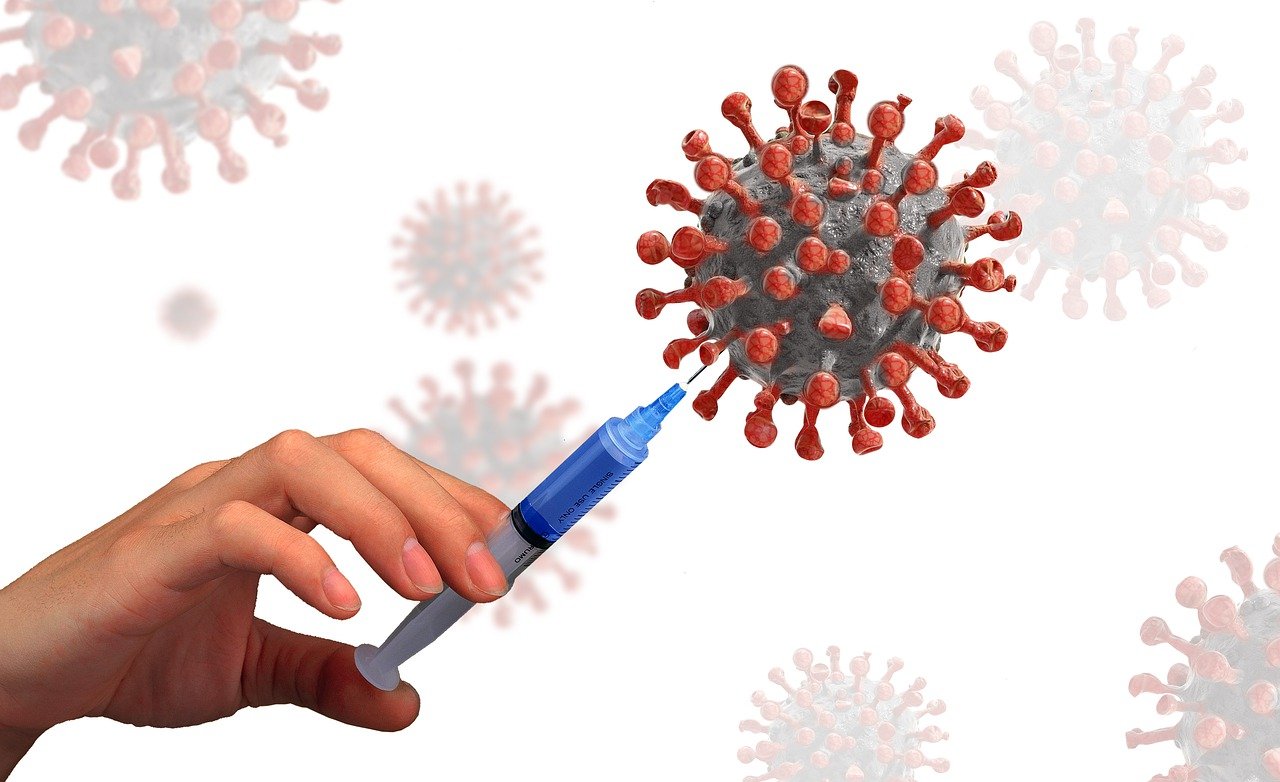This week, the Johnson & Johnson vaccine rolled out in a number of locations across the U.S., giving Americans three vaccines to fight the COVID-19 pandemic. With such good, hopeful news, Keeping Hope writer Eva Dean Folkert sat down (via Google Meet) with Hope College’s resident virology expert, Dr. Ben Kopek, associate professor of biology. Kopek offers his wisdom and knowledge on the three vaccines’ safety and effectiveness, on herd immunity in the U.S, on global vaccines, and on hope for the future.
First though,
A Summary of Vaccine Similarities and Differences
| Pfizer-BioNTech | Moderna | Johnson & Johnson | |
| Efficacy | 95% | 95% | 72 % against moderate illness. 85% effective against severe disease |
| Dosage | Two doses given 21 days apart | Two doses given 28 days apart | One dose |
| Storage/Timing | At between -80ºC to -60ºC. (The FDA has now eased up on that requirement a bit.) Refrigerator storage for five days and must be used within six hours of being thawed and diluted. | At about -20ºC, or about the temperature of a home freezer | Simple refrigeration |
| Additives (ie, antibiotics, preservatives) | None | None | None |

Eva Dean Folkert: Now that there are vaccine choices in the U.S., should Americans have a preference, or should they take whatever is available, whenever it is available to them?
Ben Kopek: The three vaccines that received authorization in the US have all been shown to be safe and effective. You should absolutely take whatever is available when you have that opportunity. There are differences in the efficacy, yes, but there are several things to look at there, some nuances to be aware of. With Johnson & Johnson, they were looking at moderate to severe disease. And as far as preventing severe disease, it is 85% effective. So that’s in line with Moderna and Pfizer. More importantly, no one in that Johnson & Johnson trial died. So, you could say it’s 100% effective in preventing death. People may say, “Well, I want the one that’s 95 percent, not the one that’s 72 percent effective.” But all three are safe and very effective in what they are intended to do.
EDF: So rolling out three vaccines in a year’s time, that’s a big deal, right?
BK: It’s very impressive to me, and it’s something I never thought would happen. I don’t think a lot of scientists thought it was possible either. It really, though, built on decades of advances in vaccine research that we’ve been able to take advantage of very quickly. So, it wasn’t completely out of the blue. These (methods) were in place just through basic research over the years. What really drove it, I think, was some expediency and also a large amount of money.
Also, unfortunately, because the COVID-19 outbreak was so big, it was pretty easy to test the vaccine. So, to have these trials, you need to be able to inoculate enough people and then have enough people actually get disease to be able to see whether the vaccine is effective or not. And because we have such a big outbreak worldwide, that was able to happen very rapidly.
In contrast to the Ebola outbreak in West Africa in 2014, by the time they had some vaccines developed, also very rapidly, the outbreak was over. So, they couldn’t really test those. They had to wait and wait several years for another round. So, each vaccine is going to be a little bit dependent on the virus, the disease and how prevalent it is. But certainly, this is just a fantastic achievement.
EDF: Now the U.S. has three vaccines. Thoughts or opinions when the pandemic might weaken even more in this country, or is it too early to tell?
BK: It’s hard to make predictions, but I think we’re already seeing the effects of these vaccines. Looking in the news and what the predictions are already, they’re saying 70 to 80 percent of people need to get the vaccine to get to herd immunity. The latest estimate I’ve seen is September. But there’s been 20-25 million people who have been infected with the virus in the US, and that’s probably an underestimate. They did some surveys last fall looking at how many people actually had antibodies who did not test positive, and they think the number of people who were actually infected was probably about three or four times that (20-25 million infection rate).
So, we’re looking at maybe 60 to 80 million people who are already infected, who presumably have some level of immunity. And then, we’re getting another 20 to 40 million vaccinated pretty soon here. We’re getting close to 30 to 40 percent of the US population with immunity. So, I think we’re already seeing some of the effects of the vaccine and prior infections. Historically, that 30 to 40 percent of people who have an immunity is a place where you would start to see some reduction in disease like when the polio vaccine rolled out in the 1950s. I think we’re already seeing that. I mean, it’s still a way to go, but I’m hopeful.
EDF: Will this be a vaccine that we’ll need on an annual basis like the influenza vaccine? Or will it be one and done?
BH: It’s really hard to predict (vaccine) durability right now. For some vaccines, like the measles vaccine, it essentially has lifetime durability whereas you have to get an influenza or flu shot every year. A lot of that is related to the virus itself and how quickly it changes. The influenza virus mutates and reassorts, and it can change quite a bit year to year.
But if I had to guess, based on basic virology, I would guess that this would be more durable than the influenza vaccines, but probably less durable than something like the measles vaccine or the HPV (human papillomavirus) vaccine.
EDF: We hear about vaccines that have been developed in China and in Russia. The United Kingdom has the AstraZeneca vaccine. Why aren’t those more widely distributed?
BK: For the US, there has to be certain criteria met from trials. Maybe a good example of that is the AstraZeneca vaccine approved in the U.K., but not in the US. The FDA doesn’t merely accept results from other countries. So, it’s a regulatory decision (not to use those other countries’ vaccines). I also don’t know if the US has access to all the clinical trial information from those other countries and whether that clinical trial data, if they had it, would be sufficient for the FDA to grant approval for those.
China has developed three different vaccines. One vaccine approved in China is being used in the United Arab Emirates, also Bahrain and Egypt. Another Chinese vaccine is used in Brazil.
Interestingly, the Russian one uses the same platform as the Johnson & Johnson vaccine. It’s essentially the same vaccine there. I would expect the Russian vaccine — called Sputnik V — would be effectively the same thing as the Johnson & Johnson vaccine.
EDF: Will there be any other vaccines coming available in the U.S. in the near future?
BK: Yes. The AstraZeneca is in the final stage of clinical trials in the U.S., and I would expect that that would be available in the US as well later this year. There is also one called Novavax, which is also undergoing U.S. clinical trials. So maybe we’ll have up to five vaccines by the end of the year.
EDF: Thanks, Dr. Kopek. Any final thoughts for our readers?
BK: I could talk a lot about vaccines, but I guess the take-home is that these vaccines have all been shown to be safe and effective. We shouldn’t worry about taking them. Take whichever one of these that you are offered. And take them with confidence and gratitude.



Excellent article. I appreciate Dr. Kopek’s knowledge and his attitude of hope.
I’m leaning toward J&J version.
Thank you for comparing and contrasting the three vaccines. This article is informative and succinct. I appreciate the straightforward reporting and statistics. Very helpful – thank you!
I appreciate the information supplied through this article. A very crucial piece of information has NOT been included, however, that ought to be, especially for the fact that HOPE is a Christian college. The information that should be given so that informed, ethical choices can be made is that, the vaccine made by Johnson and Johnson contains substances made from aborted fetuses. Please inform correctly and responsibly.
Another difference between the vaccines is that the Johnson & Johnson is made using cell lines originally established from aborted fetal tissue.